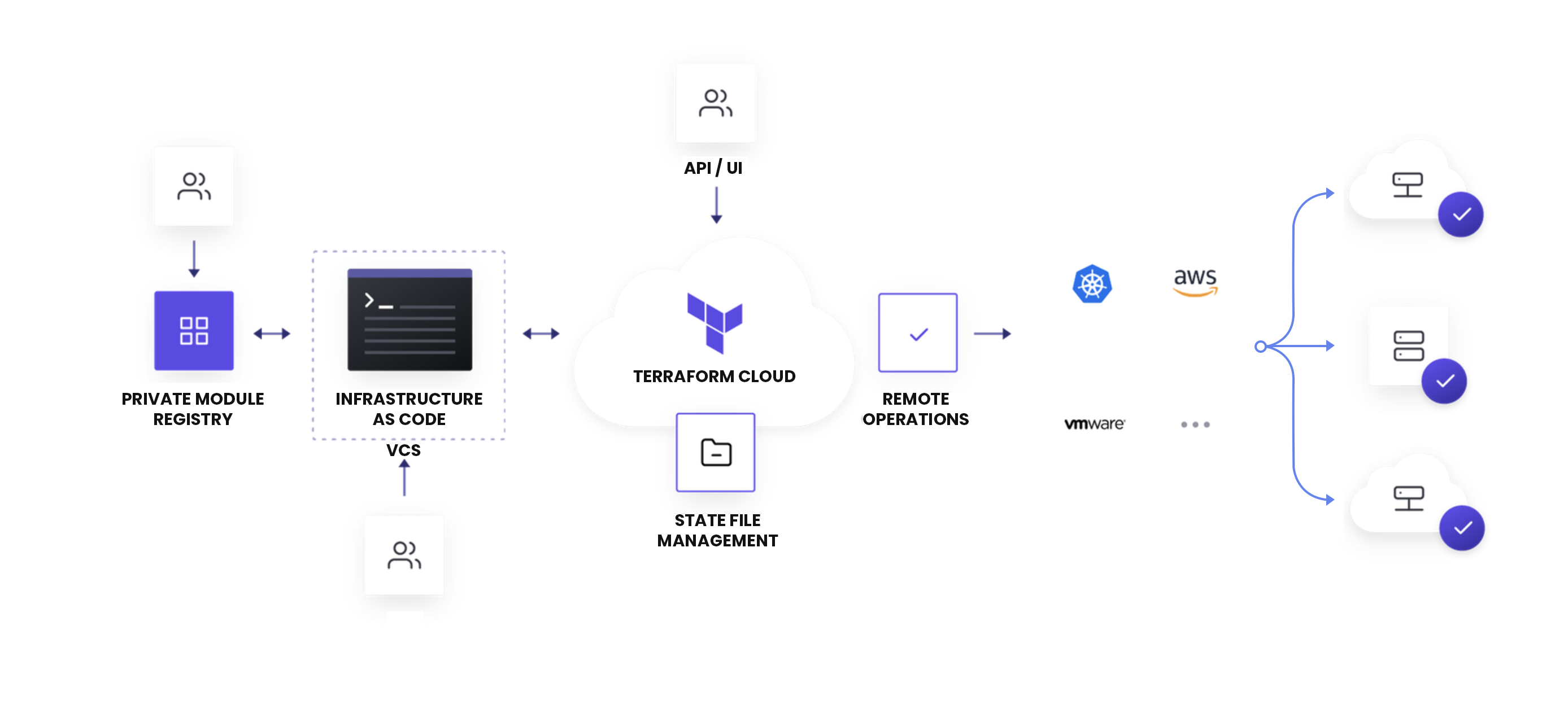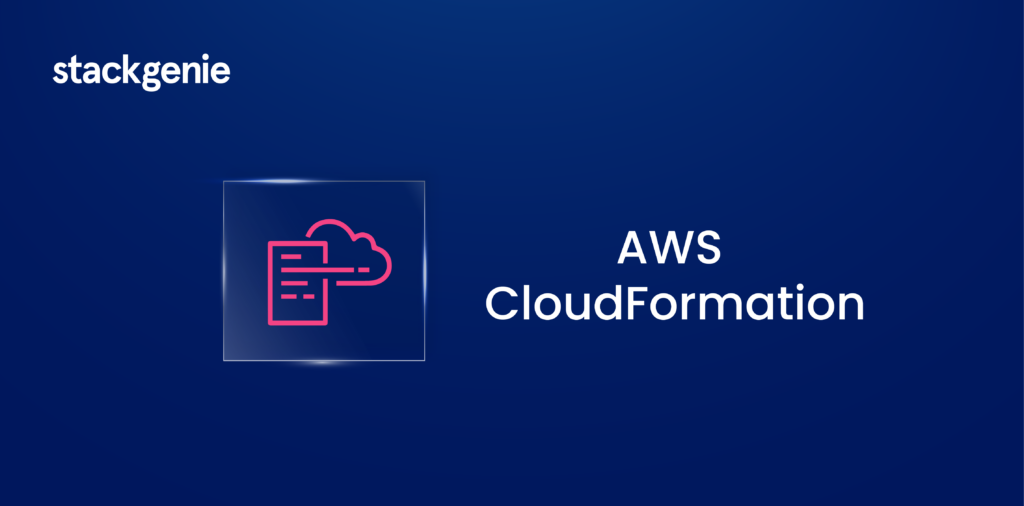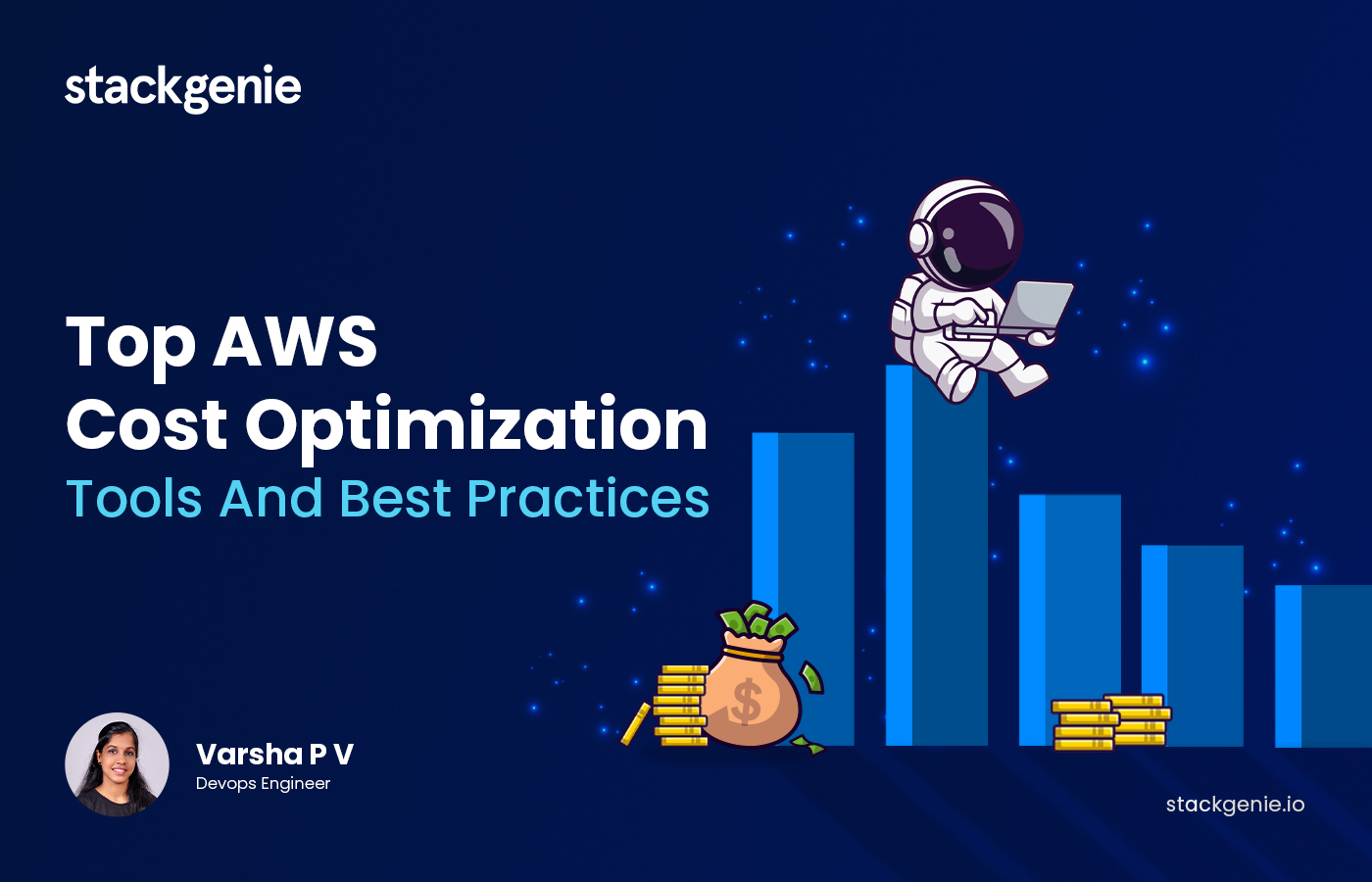You are under tremendous pressure to innovate—to bring new products to market, enhance operational efficiency, and stay ahead of competitors. Every decision impacts your organization’s agility and growth, and the stakes have never been higher.
Amid these challenges, two robust solutions stand out: CloudFormation and Terraform. Each tool offers distinct advantages, but which one will truly empower your organization to excel? As we delve into the strengths and challenges of these contenders, we’ll provide the insights you need to make an informed choice that aligns with your strategic vision and positions your business for success in the cloud.
Let’s get into the details!
What is AWS CloudFormation, and how does it work?
AWS CloudFormation is Amazon’s proprietary IaC tool, designed specifically for AWS environments. CloudFormation allows users to define their AWS infrastructure using JSON or YAML templates. With these templates, you can describe everything from simple EC2 instances to complex multi-tier architectures.
CloudFormation takes your defined template and creates a “stack”—a collection of AWS resources defined by your configuration. It is used to provision, update, and manage the resources as a single unit. Whether you’re deploying hundreds of services across multiple regions or a simple S3 bucket, CloudFormation automates the entire process.
What is Terraform, and how does it work?
Terraform, developed by HashiCorp, an AWS partner and member of the AWS DevOps member competency, is a multi-cloud IaC tool that enables users to manage infrastructure across various cloud providers like AWS, Azure, and Google Cloud. Its flexibility makes it ideal for organizations running hybrid or multi-cloud environments.

Terraform uses HashiCorp Configuration Language (HCL) to define infrastructure. It allows teams to deploy and manage services across different cloud platforms within a single template. Plus, it maintains a state file to track infrastructure changes and determine what updates are required during each deployment.
10 Key Differences Between CloudFormation and Terraform for Strategic Cloud Management
Let’s dive into the specific differences between AWS CloudFormation and Terraform, focusing on factors relevant to your environment.
1. Cost Management
CloudFormation is free to use. Businesses only pay for the AWS resources they consume. It helps companies better manage budgets when working exclusively within AWS.
Terraform is also free but allows organizations to optimize cloud costs across multiple providers. Its ability to manage resources across platforms can help businesses reduce infrastructure costs using cost-saving features from different cloud vendors.
Decision-Making Factor– Terraform provides companies with cost savings opportunities across multiple cloud platforms. For AWS-exclusive operations, CloudFormation offers seamless cost management without additional complexities.
2. Vendor Lock-In Risk
As an AWS-native tool, CloudFormation locks businesses into the AWS ecosystem. While this provides deep integration with AWS services, it limits the flexibility to adopt a multi-cloud strategy in the future.
Being cloud-agnostic, Terraform mitigates vendor lock-in by enabling businesses to manage resources across multiple cloud providers, including AWS, Azure, Google Cloud, and on-premise environments.
Decision-Making Factor – Organizations with a long-term cloud flexibility and independence strategy benefit more from Terraform, while AWS-dedicated businesses can leverage CloudFormation without worrying about lock-in.
3. Ease of Use and Learning Curve
For businesses heavily invested in AWS, CloudFormation provides a familiar environment, making adoption easier for teams already accustomed to the AWS ecosystem. It reduces training time and helps companies move faster.
Although Terraform’s flexibility offers broader capabilities, it has a steeper learning curve, which may require additional time and resources for team training.
Decision-Making Factor – Companies focused on rapid deployment and simplicity prefer CloudFormation. Large enterprises with multi-cloud operations may see the value in investing in Terraform for long-term scalability.
4. Scalability and Future Growth
CloudFormation is ideal for organizations that rely exclusively on AWS and offer seamless scaling of AWS infrastructure. However, its scalability is limited to the AWS platform alone. Nevertheless, it can become restrictive if the business plans to expand to other cloud environments.
Terraform excels in scalability across multiple cloud environments. Businesses planning global expansions, multi-region deployments, or hybrid-cloud infrastructure can scale resources more efficiently using Terraform.
Decision-Making Factor – If your organization plans to grow beyond AWS, Terraform offers greater flexibility. For AWS-centric growth, CloudFormation provides a streamlined solution.
5. Disaster Recovery and Risk Management
CloudFormation’s built-in rollback feature ensures safe deployments by automatically reverting failed infrastructure changes. It minimizes downtime and reduces the risk of human error, which makes it a strong choice for mission-critical AWS applications.
Terraform’s ability to manage infrastructure across multiple clouds gives businesses more disaster recovery options. Using different cloud providers helps minimize the risk of service outages and ensure business continuity.
Decision-Making Factor – CloudFormation is highly effective for risk management within AWS, while Terraform enables more robust disaster recovery strategies by leveraging multi-cloud redundancy.
6. Integration with Business Tools and Compliance
CloudFormation tightly integrates with AWS’s native tools, which allows organizations to ensure compliance, security, and governance within AWS. It reduces the need for external tools and simplifies compliance management.
On the contrary, Terraform’s open-source nature allows it to integrate with a broader range of business tools, including third-party compliance and security platforms. Its flexibility is ideal for businesses that require custom or multi-cloud compliance solutions.
Decision-Making Factor – For businesses needing robust AWS-native compliance, CloudFormation is ideal. However, Terraform offers broader integration options for companies requiring complex or multi-platform compliance standards.
7. Support and Ecosystem
As a native AWS tool, CloudFormation comes with extensive official AWS support, including AWS customer service, training resources, and detailed documentation. AWS customers can access many resources directly related to CloudFormation’s features and integrations.
While Terraform was previously open-source, HashiCorp recently shifted to a Business Source License (BSL), which restricts some commercial uses of the tool. Despite this change, Terraform maintains a large, active community that contributes to modules, plugins, and integrations available through HashiCorp’s ecosystem. For businesses seeking a fully open-source experience, OpenTofu, a community-driven fork of Terraform, may provide a viable alternative. Terraform Cloud and Terraform Enterprise are also available for organizations requiring advanced support and collaboration features, which are premium.
Decision-Making Factor – CloudFormation provides businesses with direct support from AWS, which benefits companies prioritizing formal support services. For multi-cloud needs and flexible infrastructure management, Terraform offers strong community resources and professional support through its enterprise options.
8. Time-to-Market and Deployment Speed
CloudFormation is designed to work seamlessly within AWS, enabling faster deployment of AWS resources with minimal configuration. It accelerates time-to-market for new services, especially for businesses deeply integrated into AWS infrastructure.
While Terraform offers flexibility across multiple clouds, setting up and configuring resources can be more complex. It requires slightly longer initial deployment times than CloudFormation, especially for teams unfamiliar with multi-cloud environments.
Decision-Making Factor – For businesses aiming for quick AWS deployments, CloudFormation may offer faster results. However, Terraform’s flexibility may be worth the slightly longer initial setup time for those looking at a multi-cloud strategy.
9. Talent Availability and Expertise
Since CloudFormation is tightly integrated with AWS, many AWS-certified professionals are already familiar with the tool. Thus, it is easier for businesses to find talent with specific CloudFormation expertise, reducing hiring time and training costs.
Terraform, being a multi-cloud tool, requires more specialized expertise in managing infrastructure across different providers. Due to Terraform skills being in demand, finding professionals with deep multi-cloud expertise might be more challenging and lead to higher hiring or training costs.
Decision-Making Factor – Businesses with a heavy AWS focus may find it easier to source CloudFormation expertise, while those pursuing multi-cloud strategies may need to invest in upskilling or hiring talent proficient in Terraform and multi-cloud environments.
10. Long-Term Maintenance and Operational Complexity
For businesses that intend to remain entirely within the AWS ecosystem, CloudFormation offers low operational complexity, as it’s designed to work natively with AWS services. Maintenance and updates are streamlined, and the business won’t need to worry about managing integrations with other cloud providers.
Terraform’s multi-cloud flexibility comes with a trade-off in terms of operational complexity. Managing infrastructure across different cloud providers requires more oversight, as businesses must account for varying APIs, services, and configurations from each platform.
Decision-Making Factor – CloudFormation simplifies long-term maintenance for AWS-only businesses by reducing operational complexity. On the other hand, Terraform’s flexibility introduces more complexity but allows firms to future-proof their infrastructure with a multi-cloud approach.
The ultimate face-off: CloudFormation or Terraform for your business needs
| Factors | CloudFormation | Terraform |
| Cost Management | Integrated with AWS pricing; predictable costs for AWS resources | Cost estimation tools available for multiple providers; potential for cost savings through multi-cloud strategies |
| Vendor Lock-In Risk | High; tightly coupled with the AWS ecosystem | Low; supports multiple cloud providers, reducing dependency on a single vendor |
| Ease of Use and Learning Curve | Easier for teams familiar with AWS; requires knowledge of AWS services | Intuitive interface; HCL is user-friendly but may require training for multi-cloud management |
| Scalability and Future Growth | Best suited for AWS-centric architectures; may limit future growth if locked into AWS | Highly scalable across various cloud environments, supporting diverse growth strategies |
| Disaster Recovery and Risk Management | Built-in recovery options within AWS; change sets allow for risk assessment | Strong disaster recovery capabilities; plan command provides a preview of changes to mitigate risks |
| Integration with Business Tools and Compliance | Seamless integration with AWS services; compliance features tied to AWS | Flexible integration with various tools and platforms; supports compliance across multiple clouds |
| Support and Ecosystem | AWS support available; limited to AWS community resources | Extensive community support, third-party integrations, and a broad ecosystem of modules |
| Time-to-Market and Deployment Speed | Slower deployment due to AWS-specific processes; may require manual intervention | Faster deployments with parallel resource creation, enabling quicker time-to-market |
| Long-Term Maintenance and Operational Complexity | AWS manages much of the infrastructure; it may require ongoing AWS expertise | Requires ongoing management but offers flexibility to adapt to changing business needs |
| Talent Availability and Expertise | AWS expertise is widely available; it may limit hiring options to AWS specialists | Growing demand for Terraform skills; broader talent pool due to multi-cloud capabilities |
| Flexibility in Resource Management | Limited to AWS resources; less flexibility in managing multi-cloud environments | High flexibility in managing resources across multiple cloud providers |
| Change Management and Version Control | Change sets provide a way to preview changes, but version control is AWS-centric | Built-in version control and state management, allowing for better tracking of changes |
| Community and Third-Party Tools | Limited to AWS community; fewer third-party tools available | Strong community with a wide range of third-party tools and modules for enhanced functionality |
| Customization and Extensibility | Limited customization options within AWS services | Highly customizable with the ability to create modules and integrate with various tools |
| Performance Monitoring and Analytics | AWS CloudWatch provides monitoring but is AWS-specific | Integrates with various monitoring tools, offering flexibility in performance analytics |
When to Use CloudFormation for AWS?
CloudFormation is a clear winner for organizations working exclusively within AWS. Its tight integration with AWS services makes it the best choice for AWS-centric use cases.
Ideal Scenarios for CloudFormation
1.Deep AWS Integration
For infrastructure heavily reliant on AWS services like Lambda, EC2, and S3, CloudFormation offers native support for seamless management.
Example – An e-commerce company using AWS Lambda for serverless functions and S3 for storage can benefit from CloudFormation’s tight integration with these services. By using CloudFormation, the company ensures that its infrastructure is seamlessly managed and updated, avoiding integration issues.
2. Cost Efficiency
As CloudFormation is free, you only pay for the AWS resources you use, which makes it a cost-effective option for budget-conscious organizations.
Example – A non-profit organization with limited funding can use CloudFormation to deploy its AWS infrastructure without incurring extra costs beyond the resources it consumes. It helps the organization stay within budget while still leveraging AWS’s robust services.
3. Automated Rollbacks
CloudFormation’s automatic rollback feature reduces the risk of failed deployments by reverting changes and minimizing manual intervention.
Example – A fintech startup deploying complex AWS setups can rely on CloudFormation’s rollback feature to automatically revert changes if a deployment fails. It makes the startup infrastructure stable and operational by reducing the need for manual fixes.
When to Use Terraform for AWS?
Terraform is ideal for businesses that require multi-cloud deployments or plan to expand beyond AWS in the future. Its flexibility and support for hybrid environments make it a robust choice for more complex scenarios.
Ideal Scenarios for Terraform
1. Multi-Cloud and Hybrid Cloud
If you need to manage resources in AWS, Azure, and GCP simultaneously, Terraform’s multi-cloud support is unparalleled.
Example– A company managing global services across AWS and Azure can use Terraform to coordinate resources seamlessly, ensuring consistent management across diverse cloud platforms without being locked into a single provider.
2. Reusability Across Projects
Terraform’s modules provide flexibility when you need reusable infrastructure components that can be deployed across different cloud environments.
Example – A development team working on multiple projects within AWS and Google Cloud can utilize Terraform modules to standardize and reuse infrastructure components. It speeds up deployment times and maintains consistency across projects.
3. Open-Source Flexibility
Terraform’s open-source nature ensures that the community continuously contributes new providers and integrations. It allows you to stay ahead in a multi-cloud world.
Example – A tech startup exploring new cloud technologies can use the latest community-contributed Terraform providers. It integrates cutting-edge tools and services, keeping its infrastructure agile and adaptable.
4. Adapting OpenTofu
OpenTofu, governed by the Linux Foundation, fosters open-source contributions that enable teams to access the latest providers and integrations. It ensures continuous innovation in multi-cloud environments.
Example – A financial services company can use OpenTofu’s community-driven ecosystem to integrate new compliance tools as soon as they become available. This open-source flexibility keeps its infrastructure agile and compliant without the limitations of proprietary licensing.
5. Terraform Workspaces
In Terraform Cloud, users can configure specific workspace settings, such as enabling Auto-Apply for non-production environments to streamline deployments and disabling it for production to ensure manual approval and oversight.
An organization can use Terraform Workspaces to manage development, testing, and production environments. Auto-Apply could be enabled in the development workspace for quick changes, while the production workspace would require manual approval for changes to ensure stability and security.
Making the Final Call: CloudFormation or Terraform?
In the debate between CloudFormation and Terraform, the right choice ultimately depends on your organization’s specific needs and strategic goals. CloudFormation offers seamless integration within the AWS ecosystem, making it an excellent choice for those heavily invested in AWS services. On the other hand, Terraform’s multi-cloud capabilities provide the flexibility and portability that many businesses seek in today’s diverse cloud environments.
As you weigh your options, consider how these tools align with your vision for innovation and growth. If you’re looking for expert guidance and robust Terraform services, look no further than Stackgenie. With a team of seasoned professionals, Stackgenie helps your organization achieve maximum efficiency and scalability in its cloud infrastructure.
Take the next step in transforming your cloud strategy. Contact us today to discover how Stackgenie can support your journey!
FAQs
1. Can Terraform and CloudFormation be used together?
Yes, Terraform and CloudFormation can be used together, but they complicate operations. Managing both can lead to coordination issues and increased overhead. For a more streamlined approach, using Terraform exclusively, even for AWS resources, is often preferable.
2. Which is easier for teams to adapt: Terraform or CloudFormation?
Of course, Terraform, having a learning curve, offers broader capabilities for teams, such as flexibility, multi-cloud support, and consistency across various platforms. For businesses planning to scale beyond AWS, Terraform provides a future-proof, adaptable solution.
3. How do AWS CloudFormation and Terraform integrate with other DevOps and CI/CD tools?
CloudFormation integrates with AWS CodePipeline and AWS CodeBuild, while Terraform integrates with tools like Jenkins, GitLab CI/CD, and Azure DevOps through various plugins and APIs.
4. Can I manage on-premises infrastructure with Terraform?
Yes, Terraform can manage on-premises infrastructure through its extensive list of providers, including integrations with platforms like VMware and various network equipment.
5. Is Terraform cost-effective than CloudFormation for AWS environments?
Yes, Terraform is cost-effective for AWS environments, especially when managing resources across multiple clouds. Its flexibility allows for optimized infrastructure management, reducing operational costs and enhancing resource allocation decisions, leading to greater overall efficiency






